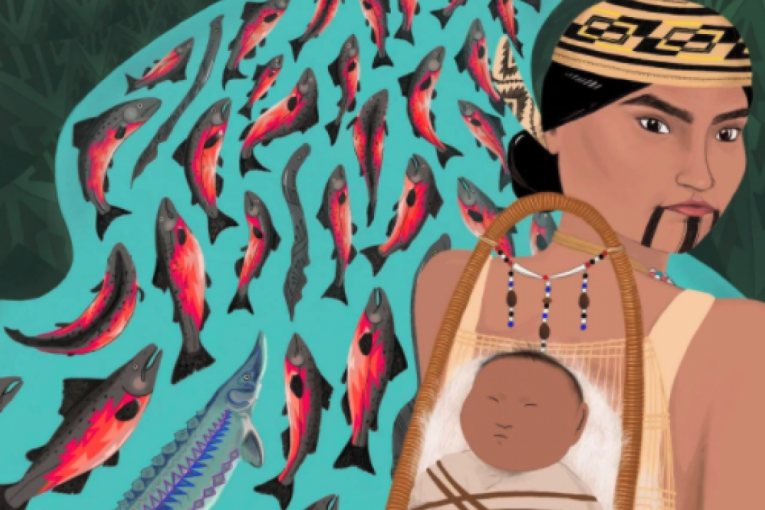
 By Diana Zhu
By Diana Zhu
On Apr. 26, this year’s UC Davis Native American Studies (NAS) graduate students began their 9th annual research symposium titled “From Red Power to Wallmapu Libre and Land Back.”
This year’s theme seeks to highlight how academia could go further in promoting Indigenous knowledge, methodologies and scholarship; an effort that has been largely ignored in western academia.
This year’s symposium was held from Monday to Thursday this week, with the students hosting events each day from 10 a.m. to 2 p.m.
“In NAS at UC Davis, we strive to become what our founder Jack D. Forbes called ‘Warrior Scholars’ and our symposium this year represents that,” said Haliehana Stepetin, President of the NAS Graduate Student Association.
Jack D. Forbes is an acclaimed author, activist and professor emeritus of Native American studies at UCD, whose leadership and collaboration with other faculty members made Native American studies an academic department at the university in 1993.
Forbes made UC Davis one of the first and few major universities to begin the movement in understanding the importance of educating those who have the opportunity to study on Indigenous homeland.
During the symposium, Pam Gonzales, the Patwin Elder, shared that she was invited to speak on the UC Davis Land Acknowledgment Statement, which states:
“UC Davis pays homage to the indigenous people and land on which the Davis campus is located. Following consultation with members of the Patwin native community, the campus is pleased to provide the following ‘Land Acknowledgement Statement’ that can be used in oral or written form at events as deemed appropriate. The campus encourages those who are interested to use the following language, without edit:
We should take a moment to acknowledge the land on which we are gathered. For thousands of years, this land has been the home of Patwin people. Today, there are three federally recognized Patwin tribes: Cachil DeHe Band of Wintun Indians of the Colusa Indian Community, Kletsel Dehe Wintun Nation, and Yocha Dehe Wintun Nation.
The Patwin people have remained committed to the stewardship of this land over many centuries. It has been cherished and protected, as elders have instructed the young through generations. We are honored and grateful to be here today on their traditional lands.”
Gonzales took on a disappointed tone in reference to the land acknowledgment, saying a mere acknowledgment has been one of the “mediocre efforts” historically made by institutions that take advantage of occupying Native land and does not take direct action.
She said some things that could be done are things like integrating Native American studies into the curriculum, hiring Native professors or encouraging students to visit tribe-specific areas.
Gonzales emphasized that teaching the histories of Indigenous homelands is how the very same cultures are preserved and continue to adapt and thrive.
The following panels highlighted how Indigenous studies transcend national borders and integrate many fields of study, ranging from visual art and literature to botany and geography.
The first panel focused on California Native cosmologies and relationalities of place, with Cinytha Ammerman presenting “The Dream of a ‘Chilean California’ and the Colonization of Wallmapu.”
Then, Sage Innerarity presented “(Re)awakening and (Re)collecting: Creation Stories and Creating Native Futures.”
Chimaway Lopez and Casmali Lopez then spoke on “From ‘Chumash Studies’ to Chumash Resurgence: Realizing Chumash Political Expression as Grounded Indigenous Theory from the Land/Water to the Academy and Back.”
There was then a keynote address from the Confederated Villages of Lisjan’s Corrina Gould, who co-founded the Sogorea Te’ Land Trust and Indian People Organizing for Change.
Another keynote speaker was the Yurok’s Sammy Gensaw, Director of Ancestral Guard, environmental activist and youth leader.
The second panel had a theme focused on Indigenous relations with lands and waters in film.
Katelyn Stiles screened a film titled “Yáa at Wooné (Respect for all Things),” followed by Natasha Giraudie and Michael “Pom” Preston presenting “One Word to Heal our Relationship with the Earth.”
“We worked hard this year to bring together an exciting line-up of speakers and graduate students engaging in Indigenous resistance and resurgence movements from the Arctic to Tierra Del Fuego… Indigenous research-creation from around the world is part of what makes Native American and Indigenous studies research and praxis so innovative and powerful,” Stepetin said.
 Diana Zhu is a fourth-year transfer student from Rancho Cucamonga, CA. She is majoring in Chinese and minoring in Professional Writing.
Diana Zhu is a fourth-year transfer student from Rancho Cucamonga, CA. She is majoring in Chinese and minoring in Professional Writing.
Support our work – to become a sustaining at $5 – $10- $25 per month hit the link:

Hence, the casino on traditional
gaminggambling grounds.A monopoly, for those who “qualify” for the applicable designation – which is sometimes “fought over”, internally.
And the rise of the Alaska Native Corporations, no doubt to live as they did for thousands of years (e.g., logging, mining, oil extraction, etc.).
Neither the casino nor the mining benefit all native peoples. There are certain “in” individuals, and others who are not federally recognized, or individuals who ‘find’ themselves without a tribe. The powers that be have allowed a system that both oppresses and gives favored status to specific native people, while many natives remain the victims of a system they did not set the rules of. I agree on the monopoly of casinos and the irony of native corporations defiling the land — but this should be laid at the feet of the powers that be and a select group of ‘connected’ natives taking advantage of opportunity as the system has defined it, often at the expense of other natives.
By the way, doesn’t this type of article “ignore” the landowners which preceded the inclusion into the U.S.? Namely, the Spanish/Mexican land grant owners? Did those grants include the land upon which UC Davis is now located? As well as the city, itself?
Isn’t that also what allowed Sutter to settle in the area now known as Sacramento, and ultimately resulted in the loss of “his” land after California became a U.S. state (or thereabouts)?
Or, did UC Davis “take the land” directly from Native Americans? Kicked them right out? Is that the suggestion?
The entire area was part of a Mexican land grant.
But truth be told, I’m actually more “impressed” that you felt it was appropriate to comment on the author’s appearance, in her photo. Kind of creepy, really.
At least I just made fun of the artwork, in a self-deprecating manner.
Nice to see the legacy of Jack Forbes continue. What a great man and a great legacy.
False.
List of ranchos of California – Wikipedia
Just for the record:
https://www.cityofdavis.org/about-davis/history-symbols#:~:text=The%20City%20of%20Davis%20sits,to%20settle%20in%20this%20area.
https://davisdowntown.com/history-of-davis/
https://en.wikipedia.org/wiki/Davis,_California